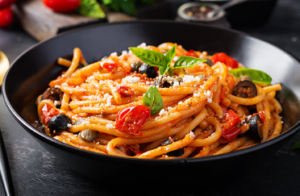When adequately prepared, pasta emulsifies into a magical coating that clings to every nook and cranny of the noodles. It’s the finishing touch that restaurants routinely use to add one final note of perfection to their dishes.
Place flour on a work surface and create a well in the centre with high sides. Add eggs and mix with a fork.
 How to Make Pasta
How to Make Pasta
The key to making great homemade takeaway pasta is a little technique. The pasta must be completed and cooked just right so it clings to the sauce and doesn’t fall off the plate. The secret is to use more starch in your pasta dough and add cooking water to your sauce, which will help it thicken and emulsify. A little extra fat in your sauce, such as olive oil or butter, can also help the pasta cling to the sauce.
Pasta is easy to make at home, especially if you have a KitchenAid stand mixer and some of the pasta attachments:
- Combine all ingredients in the mixer bowl and mix on low speed until everything is combined.
- Gradually add small amounts of flour until the dough forms a ball and no longer sticks to the sides of the bowl.
- Knead the dough for about ten minutes.
If you don’t have a stand mixer, you can make the same pasta in a large, heavy-duty food processor fitted with a dough blade.
Once your dough is ready, shape it into a ball with your hands and wrap it in cling film (this stops drying out). Let the dough rest for 30 minutes, then roll it on a work surface well-floured with durum wheat flour. For classic pasta shapes such as tagliatelle and pappardelle, roll out the dough in a long strip until it is about 1cm thick, then cut it into strips (see photo below). For pici, roll the pieces of dough, one at a time, to resemble thick spaghetti.
If you’re making a lot of pasta, you can use a pastry roller to cut the dough into various shapes. Then, either transfer the pasta to a wire rack to dry or swirl it into little noodle nests and lay them on a well-floured surface to dry for about 30 minutes. If you’re freezing the pasta, put the noodle nests into a freezer bag, which will keep for nine months.
Ingredients
A good pasta dish is beautiful, with perfectly al dente noodles, a glossy sauce that clings to every noodle and a bright, bold and Instagram-ready garnish. It’s a delight to eat, but replicating at home can be a challenge. With a few simple tricks, you can make your homemade takeaway pasta that’s just as delicious as it is gorgeous.
The secret to great pasta is high-quality flour with enough water and plenty of kneading. Getting it right means you’ll end up with a soft, elastic dough that doesn’t stick to your hands or the counter.
Using the best eggs is also crucial – choose free-range, delicious large ones with perfect yolks to give your pasta that ideal colour. Add the flour and make a well in the centre on a clean surface, then gradually mix in the eggs. When the dough is combined, knead it to eliminate any remaining air bubbles.
At this point, you can cook your fresh pasta or leave it to dry for up to two hours before storing it in the fridge; if you plan to keep it, twirl small bunches of pasta into “nests” and allow them to air dry before packing in an airtight container. Then, when you’re ready to reheat the pasta, it will be as fresh as when it was cooked. It might need a minute longer in boiling water than if you’d cooked it immediately.
Preparation
To get that professional result, you need to start with fresh and high-quality ingredients and take the time to prepare them correctly. Much of that work is done before the pasta is made – preparing the dough, resting it and then kneading it to ensure the gluten is tight enough to hold the noodles.
The dough should be dusted liberally with flour and kneaded until it becomes smooth and elastic with very few air bubbles. It is essential because it gives the pasta structure and texture. It also makes it possible to cut the pasta into whatever shape you like, whether it’s a simple fettuccine or a more complex-filled pasta. For more information about homemade takeaway pasta, click here.
